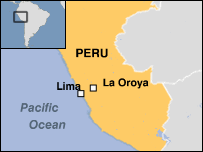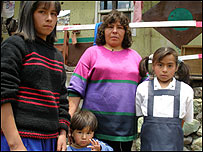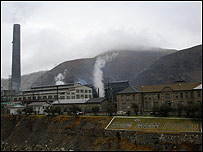Life in Peru's most polluted town
November 15, 2007 - BBC News, La Oroya
By Dan Collyns
BBC News, La Oroya
You know you are getting close to La Oroya when the already sparse vegetation on the mountainside gets thinner and eventually disappears leaving bare rock.
 (
left) The Doe Run plant in La Oroya. The
plant dominates the local skyline
(
left) The Doe Run plant in La Oroya. The
plant dominates the local skyline
Video: One family's story
On arriving at this high altitude town you can see it is dominated by a huge chimney, at 167m (547ft) believed to be one of the world's tallest.
For an unremarkable place, La Oroya has another superlative attached to its name.
The Blacksmith Institute, a US-based environmental think tank, has ranked it as one of the top 10 most polluted places in the world for the last two years.
La Oroya, home to more than 30,000 people, is a company town and many residents say nothing about the pollution for fear of losing their jobs.
One exception is Miguel Curi, who paid little attention to the multi-metal smelter until his infant daughter had a blood test.
The results showed she had three-and-a-half times more lead in her blood than is safe according to World Health Organization guidelines.
"We have put all our resources in addressing and dramatically improving our environmental performance" – Victor Andres Belaunde, Doe Run spokesman
"I asked who did this to my daughter and I arrived at the unwelcome surprise that it was the fumes from the Doe Run plant which had affected not only my daughter but thousands of children in La Oroya," said Mr Curi.
That was two years ago. Since then Mr Curi, who heads the La Oroya health movement, has met hundreds of children with blood lead levels up to six times the safe limit.
'Vicious circle'
Three years ago the Peruvian health ministry (MINSA) found that 99.9% of children in La Oroya under the age of seven had blood lead levels far above safe norms.
 And a recent study of newborn babies by neurologist Dr Hugo Villa showed
a quarter of those tested had dangerously high lead levels in their blood.
And a recent study of newborn babies by neurologist Dr Hugo Villa showed
a quarter of those tested had dangerously high lead levels in their blood.
"This means that pregnant mothers here in La Oroya are also contaminated and transmit the lead through the placenta to the newborn," said Dr Villa who has worked in La Oroya for 28 years.
"It shows that this people's health is caught in a very dramatic vicious circle and frankly the company are doing very little to resolve it."
Air quality
The smelter was already 75 years old when the Peruvian state sold it in 1997 to the US-based Doe Run Corporation as part of a privatisation drive, on the condition that emissions were cut.
Doe Run says at the time the plant was completely unregulated as Peru had only just begun conforming to international environmental laws.
The corporation says it has invested money to modernise the plant and curb emissions.
The Peruvian Labour Association and Inter-American Association for Environmental Defence say their studies indicate toxic emissions have actually increased in the last decade, in some cases substantially.
 (left)
Ruth Fajardo and her children Cinthia, Melany and Brando
(left)
Ruth Fajardo and her children Cinthia, Melany and Brando
"My twelve-year old daughter's hands are swollen with blisters. She tells
me her head really hurts, just too much"
– Ruth Fajardo, La Oroya resident
Doe Run spokesman Victor Andres Belaunde said they did not want to deny nor downplay the situation in La Oroya but that information was out of date.
"We are extremely concerned by all issues that relate to blood lead levels and all the issues that relate to the environment at La Oroya," he said.
"That is the reason why we have put all our resources into addressing and dramatically improving our environmental performance."
For the first time in La Oroya's 85-year history, Mr Belaunde said, "we are seeing monthly air quality numbers for lead within permissible limits."
The plant was also no longer a source of pollution for the local river, he added.
Mr Belaunde says there was pre-existing lead contamination in the soil dating back to before Doe Run took over the plant, and that the Peruvian government was responsible for cleaning this up.
He added that the company planned to accomplish its goal of being within Peru's environmental standards by October 2009, with the completion of two more processing plants for lead and copper.
Stunted growth
But when you meet the people forced to live day in and day out under a toxic cloud, two years seem a long way off.
Ruth Fajardo and her family live in La Oroya Antigua, the old part of the town, which is most affected by the fumes from the plant.
 (left)
The Doe Run plant in La Oroya
(left)
The Doe Run plant in La Oroya
The smelter is important for Peru's metal export industry.
She says all her children suffer from conditions caused by lead poisoning.
"My 12-year old daughter's hands are swollen with blisters. She tells me her head really hurts, just too much," she said.
"There are days when she feels she is going to faint because of the lack of air. She can't even study because of the headaches."
Lead poisoning is chronic and debilitating. It affects the central nervous system and lodges permanently in the bones, liver and brain, and is known to cause learning difficulties and stunted growth.
Peru's metal exports, driven by high global prices, are the main force behind its economic boom. With so much mining across the country, closing a smelter like the one in La Oroya is not the economically viable option.
But in another 10 years what will La Oroya, and the health of its people, be like?
Miguel Curi, for one, is pessimistic.
"As long as we have don't have a government that cares about the environment and the health of a town's population, this situation is not going to change."